#warwick.wives
Explore tagged Tumblr posts
Text
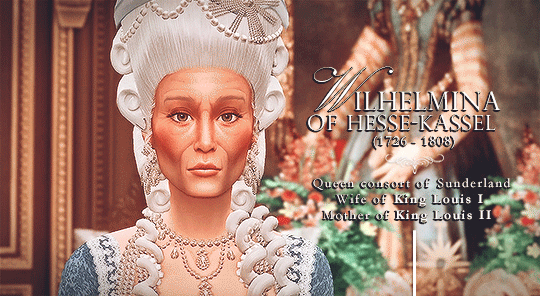
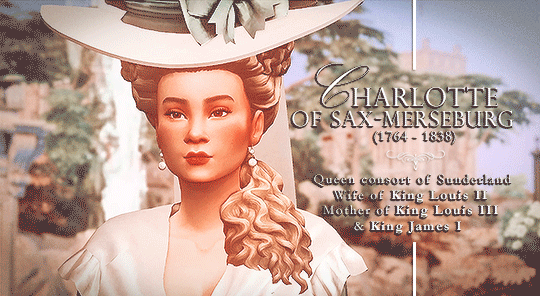
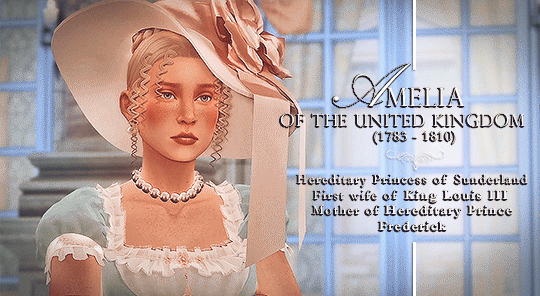


↬ Warwick Wives (1/7) | royal wives during the reigns of Louis I & Louis II, 1782 - 1817
W I L H E L M I N A was fifty-six at the time of her husband's enthronement, making her one of Sunderland's oldest queen consorts. Despite this, she was famed for her beauty and sharp wit. She had protruding, restless eyes, with a pleasant demeanour. Her representation was a source of stability during the monarchy's early days.
C H A R L O T T E was less shrewd than her mother-in-law. Undereducated and neglected, she came from an obscure German duchy on the brink of extinction. Charlotte’s desire for an informal and relaxed domestic life greatly influenced the upbringing of royal children throughout the late eighteenth and early nineteenth centuries. She remains the most prolific of Sunderland's queens, giving birth to fifteen children—seven boys and eight girls—over twenty-one years.
A M E L I A is the earliest example of a Sunderlandian consort causing a media sensation. Emily, as she was affectionately called, was beloved by the country and her husband, Louis, then Duke of Woodbine. Her marriage stemmed from Sunderland's new alliance with the United Kingdom. This alliance ultimately outlasted the marriage, for Emily would die at age twenty-seven. Her death complicated Sunderland's succession; she and Louis had one son, five-year-old Prince Frederick, who was also of weak health.
M A R I A - C A R O L I N A was the antithesis of Emily—even their hair colours highlighted this. Where Emily was pleasant and free-spirited, Maria Carolina was moody and introverted; Emily was the daughter of a King, a product of the world's largest imperial empire, Maria Carolina was the daughter of a low-ranking prince from Sweden's waining Holstein-Gottorp dynasty. Where Emily was adored by her husband, Maria Carolina hated. The two cousins had never wanted to marry and Louis, still grieving his first wife, waited two years before consummating the union. Over time, Louis grew hostile toward his wife. Running hot and cold, he alternated between ignoring Maria Carolina and tormenting her mercilessly, sometimes driving her to tears.
"If I were to suffer such maltreatment would have hung myself from the balcony at Chester long ago" - Princess Wilhemina, writing on her sister-in-law's troubles
To escape her husband's bullying, Maria Carolina undertook a wide variety of public duties. Today, several institutions and charities bear the name Queen Mary Caroline. Despite her husband's apathy and her own shyness, Maria Carolina formed a loyal circle of close friends at court. It was only after Maria Carolina died in 1841, that Louis III expressed remorse for her mistreatment. He outlived her for another ten years.
King Louis III and Queen Mary Caroline had no surviving children together. When Louis's only son, Hereditary Prince Frederick, died without issue Sunderland was left without a clear successor, promoting the 1835 Succession Crisis. This crisis would last for twenty-five years and put an immense amount of pressure on the next generation of royal wives.
[TRANSCRIPT]
insp (1) (2)
#warwick.extras#warwick.wives#gif warning#✨#ts4#ts4 story#ts4 royal#ts4 storytelling#ts4 edit#ts4 royal legacy#ts4 legacy#ts4 royalty#ts4 monarchy#ts4 screenshots#ts4 historical
186 notes
·
View notes
Text
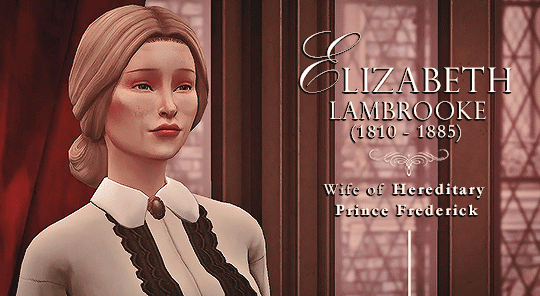
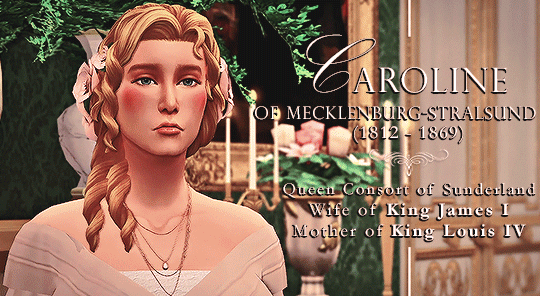
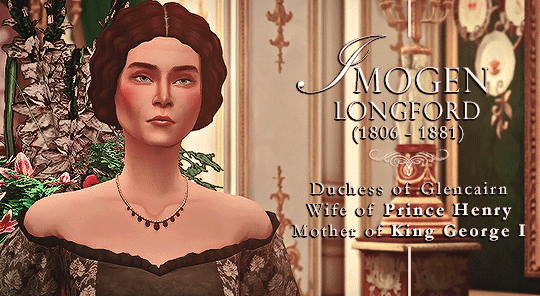

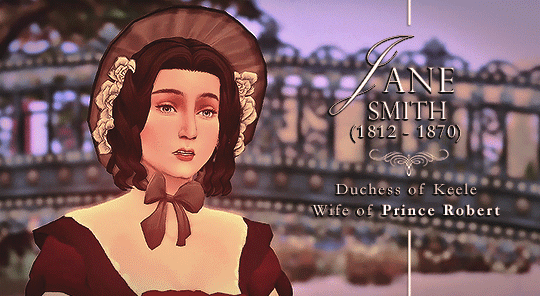
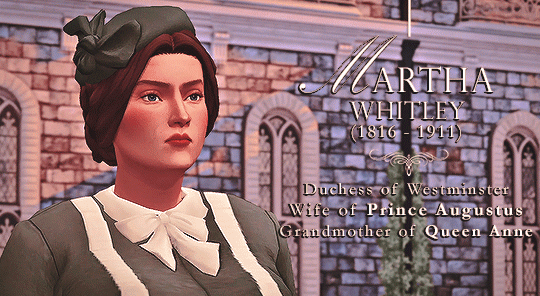

↬ Warwick Wives (2/7) | royal wives during the reigns of Louis III & James I, 1817 - 1857
Both Louis III and James I were unpopular, their reigns were characterised mostly by the royal family's struggle to produce a male heir. In the mid-nineteenth century, the middle-aged, promiscuous and ill-tempered sons of Louis II, vied for the throne. They scrambled to marry and have children. This power struggle divided their young wives, who over the years became jealous, power-hungry, and cunning.
E L I Z A B E T H was the daughter of a wealthy American merchant, the first of House Warwick's many American brides. She married Hereditary Prince Frederick, the only child of King Louis III, in 1826. Criticized as morganatic, the marriage was harmonious but deeply unpopular. Elizabeth was tiny but fierce, with Frederick calling her his "Pocket Artemis" due to her spirited personality and uncharacteristic love of hunting. During her time as Hereditary Princess, Elizabeth was a strong voice for social reforms, although her activism was pointedly ignored by the staunchly conservative king and royal dukes. Elizabeth and Frederick had no children at the time of his early death, sparking a succession crisis. Elizabeth remained close to her in-laws, but later remarried and had four children, the eldest of which was named Frederick.
C A R O L I N E married fifty-three-year-old James, Duke of Lennox when she was twenty-six. The marriage was chiefly a political one, in light of Prince Frederick's death and King Louis III's unhappy marriage with Queen Mary Caroline the Duke was increasingly likely to succeed to the throne. James despised his younger brothers, the Dukes of Glenciarn, Bessarion, Westminster, and Keele, and saw them as a threat to his inheritance. When a healthy son, the future Louis IV, was born in 1840, James was relieved.
Caroline herself was miserable. Her marriage to James had also produced several children who were stillborn or died in infancy. With her health permanently weakened, Caroline was isolated at Lennox House, where she lived with Louis separately from her husband. German by birth, she spoke broken English (although many historians believe this was an act to appear unassuming) and had a hard time adjusting to life in Sunderland. When she became Queen, her situation improved, but she attracted the ire of the Duchess of Glencairn by snubbing her son. Their rivalry would haunt Caroline for the rest of her life. While she was an affectionate mother to Louis, Caroline was intentionally cruel to James's numerous illegitimate children. She promptly banished them from court after James died in 1857.
Caroline has the great accomplishment of being the first woman to serve as a regent. During Louis IV's minority, she governed with a surprising level of competence; but she was unable to control Louis, who had grown temperamental and spoilt.
I M O G E N was stern and grim, with a sharp, unsmiling face. Despite this, in 1837 she left her home in England for the man she loved—the kindhearted Prince Henry, an amateur playwright and the third son of King Louis II. Imogen was passionately in love with her husband and she took pride in her two children. The couple's youngest, George, was the first male-line grandson of Louis II since Hereditary Prince Frederick's death, and Imogen was convinced he would be king someday.
Imogen was crushed by Henry's early death in 1840; after which she became paranoid, controlling, and antagonistic. For the next eighteen years, Imogen clung to George, fearing that his uncles would murder him to secure their own claims. When King Louis IV was enthroned in 1857, with Imogen's arch-enemy Queen Caroline serving as regent, Imogen returned to London, dragging her reluctant teenage children with her. By the time George became king in 1860, Imogen was estranged from him. The pair only reconciled after George became a father in 1862.
E L I Z A B E T H was another German princess who married a son of King Louis II. Prince Reginald's horrific reputation preseeded him, and the seventeen-year-old Elizabeth trembled on her way up to the altar. Reginald was a career soldier who lived a Spartan lifestyle and the rumours surrounding him ranged from off-putting to abhorrent. Luckily for Elizabeth, these rumours were mostly conjecture, and Reginald treated his wife with a "passing indifference". Reginald's military career was sporadic, and he left Elizabeth alone at his city estate for increasingly long stretches of time.
Elizabeth ran a carefree but lonely household. She was often seen picking flowers around the mansion's perimeter and trying to befriend the serving girls and vagabond women who passed through the estate, often giving away her possessions to win their friendship. In her later years, Elizabeth was aggravated by her late husband's debts. While Queen Alexandra, dismissed Elizabeth as peu de chose (not much), King George I was saddened when Elizabeth died.
J A N E had a habit of chewing on caraway seeds. She was pleasant, but known to pry. She came from a family of Sunderlandian aristocracy, a descendant of the Prussian entourage that followed King Louis I and Queen Whilmenina into Sunderland in the 1780s. Her family name Smith was adopted after King Louis II anglicized his own name from the German Hohenzollern to Warwick—an attempt to distance himself from Prussia. Jane married King Louis II's youngest surviving son, Prince Robert, who was fifteen years her senior. Robert was polarizing and widely despised for his controversial stint in the House of Lords. Despite this, the marriage was a happy one and Robert doted on his wife. Jane was the favourite aunt of King Louis IV but his successor, George I, had little love for her and his mother distrusted her.
M A R T H A was a large and domineering woman. Despite marrying the fifth son of King Louis II, she had a bravado that outpaced her station. Unlike her sisters-in-law, Martha remained a prominent member of the royal family during the reign of her nephew, King George I. Known to be an extravagant hostess, Dear Aunt Westminster drank and ate in excess, and habitually burned through her generous pension. She also quarrelled with Queen Alexandra, who thought her impertinent. Family drama quashed Martha's high ambitions in the later half of the 19th century. Her elder son was disinherited after marrying his mistress and her second entered a loveless political union that produced one daughter, Anne. Martha died at the age of ninety-five in 1911, making her one of the longest-lived members of the royal family. Just two years after her death, her granddaughter Anne married the future King George II.
#warwick.extras#warwick.wives#tw pregnancy loss#gif warning#✨#ts4#ts4 story#ts4 royal#ts4 storytelling#ts4 edit#ts4 royal legacy#ts4 legacy#ts4 royalty#ts4 monarchy#ts4 screenshots#ts4 historical
82 notes
·
View notes